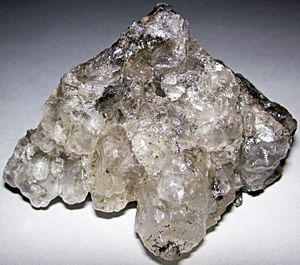Wellington Formation facts for kids
Quick facts for kids Wellington FormationStratigraphic range: Artinskian ~290–280Ma |
|
|---|---|

Halitite (Hutchinson Salt Member, Wellington Formation)
|
|
| Type | Formation |
| Unit of | Sumner Group |
| Sub-units | Lower Wellington Member, Hutchinson Salt Member, Upper Wellington Member |
| Underlies | Ninnescah Shale |
| Overlies | Nolans Limestone |
| Thickness | 500 ft (150 m) |
| Lithology | |
| Primary | Anhydrite, gypsum (Lower Wellington Member) Salt (Hutchinson Salt Member) Shale (Upper Wellington Member) |
| Other | Shale, dolomite (Lower Wellington Member) Anhydrite, gypsum, shale (Hutchinson Salt Member) Anhydrite, gypsum, siltstone (Upper Wellington Member) |
| Location | |
| Coordinates | 38°36′N 97°12′W / 38.6°N 97.2°W |
| Approximate paleocoordinates | 3°36′N 25°48′W / 3.6°N 25.8°W |
| Region | |
| Country | |
The Wellington Formation is a special layer of rock found deep underground in parts of Kansas and Oklahoma. It's like a giant history book made of stone, holding clues about what Earth was like millions of years ago. Scientists study this formation to learn about ancient environments and the creatures that lived there during a time called the Permian Period.
Contents
Discovering the Wellington Formation
The Wellington Formation is a type of geologic formation. This means it's a distinct layer of rock that scientists can identify and map. It's made up of different kinds of rocks that formed around the same time. These layers tell us a story about the Earth's past.
What is a Rock Formation?
Imagine stacking different colored blankets on top of each other. Each blanket is like a layer of rock. A rock formation is a large, continuous layer of rock that has similar features. Geologists (scientists who study rocks) give these formations names, like the Wellington Formation. This helps them understand the Earth's history.
Rocks of the Wellington Formation
The Wellington Formation is made of several types of rocks, each telling a part of its story.
- Shale: This is a soft rock made from mud and clay. It often forms in quiet water, like lakes or calm seas.
- Salt: Yes, actual salt! This rock, called halitite, formed when ancient salty water evaporated. This suggests that parts of the area were once covered by very shallow, salty lakes or seas that dried up.
- Anhydrite and Gypsum: These rocks are also formed when water evaporates. They are often found with salt deposits.
- Dolomite: This is a type of rock similar to limestone, often formed in marine environments.
- Siltstone: This rock is made from silt, which is finer than sand but coarser than clay. It forms in places where water currents are a bit stronger than where shale forms.
These different rocks are found in three main parts, or "members," of the formation: the Lower Wellington Member, the Hutchinson Salt Member, and the Upper Wellington Member. Each member has its own mix of rocks, showing how the environment changed over time.
A Look Back in Time: The Permian Period
The Wellington Formation dates back to the Permian Period, which was about 290 to 280 million years ago. This was a very long time before dinosaurs roamed the Earth! During the Permian Period, the continents were joined together in a supercontinent called Pangea. The climate was very different from today, with large deserts and some areas covered by shallow seas. The rocks in the Wellington Formation give us clues about what Kansas and Oklahoma were like during this ancient time.
Where is it Found?
You can find the Wellington Formation underground in parts of Kansas and Oklahoma in the United States. It's not usually seen on the surface because it's buried under other layers of rock. However, scientists can study it by looking at rock cores drilled from deep wells or by examining places where the formation is exposed.
What Fossils Tell Us
The Wellington Formation contains fossils. Fossils are the preserved remains or traces of ancient life. These fossils can be anything from tiny plants to ancient sea creatures. By studying the fossils found in the Wellington Formation, scientists can learn:
- What kinds of plants and animals lived in this area millions of years ago.
- What the environment was like (for example, if it was a salty lake, a shallow sea, or a dry land).
- How life has changed and evolved over vast periods of time.

